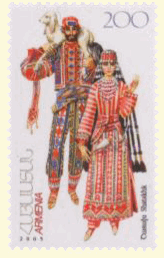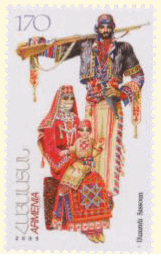 A Study Guide is available for The Greedy Sparrow and offers questions for discussion and activities that will enhance the reading experience with both younger and older students.
A Study Guide is available for The Greedy Sparrow and offers questions for discussion and activities that will enhance the reading experience with both younger and older students.
Download a pdf version of The Greedy Sparrow guide.
Click here for a study guide to accompany the Cobblestone issue on Armenian Americans.
Click here for an Addendum to the Appendix B appearing in the book, Armenia: A Rugged Land, an Enduring People.
The Greedy Sparrow: An Armenian Tale
A 2013 Nautilus Silver Award winner in the Children’s Picture Book category.
Chosen as an Honor Book in the 2012 Storytelling World Resources Awards.
A Discussion and Activity Guide for Teachers, Parents and Students
Part I: Story discussion
Part II: Armenian geography and culture
Part I: Story discussion

OVERVIEW: The characters in The Greedy Sparrow agreed to help the sparrow because he looked gentle and seemed to be in genuine need. But can looks be deceiving? Should a person always do what someone else asks him or her to do? It depends, as wise adults know, on the situation. Children (and adults, too) must exercise good judgment to protect themselves, their families, and their friends. They should be kind, but also careful. We must all stand up for ourselves when necessary.
The tale of the sparrow (jin-juh-ghoog or dzeed, in Western Armenian and Eastern Armenian dialects, respectively) has been in the Armenian oral tradition for centuries. The Greedy Sparrow, Lucine Kasbarian’s retelling of this tale, contains a plot variant that also existed in the oral tradition. While this slight twist from the most common version of the ending does not change the ageless lessons in the story, The Greedy Sparrow’s surprise ending has a particular message for today’s children and parents.
At first glance, the story is about a sparrow who takes advantage of people, “trading up” his ill-gotten gains to further his ambition of becoming a minstrel. The ending is very satisfying, as we learn that manipulation, trickery and bad intentions are — thank goodness — not rewarded.

What are the deeper lessons in The Greedy Sparrow? Here are some thought-provoking questions that teachers and parents may pose to children (and to themselves) to explore further:
- Do you think the sparrow stumbled upon the characters in this story by accident, or did he intend to take advantage of them from the very beginning? Why or why not?
- Do you think the characters in the story realized that they were taking a risk by agreeing to mind the sparrow’s property? Should they have agreed to help the sparrow in the first place? Why or why not?
- Was the sparrow being honest and reasonable when he returned and demanded something in return for his lost property? Did each person do the appropriate thing when he or she complied with the sparrow’s demand? Explain your answer.
- If you were the baker, shepherd, groom or minstrel, would you have acted differently?
- Should the baker have taken the thorn out of the sparrow’s foot? Should the baker have tossed the thorn into the oven? What do you think the baker should have answered when the sparrow demanded, “Give me the thorn or give me some bread”?
- Should the shepherd have agreed to mind the bread just because the sparrow asked him? What would you have said to the sparrow? Should the shepherd have eaten the bread just because he became hungry? Did the shepherd really owe the sparrow a sheep, or anything at all? Would you have given the sparrow anything?
- Should the groom have agreed to mind the sheep? Did the groom have the right to slay, cook and serve the sheep? What would you have done if you were the groom? Did the groom have the right to hand over his bride to the sparrow? What should the bride have said or done? What would you have said or done?
- Should the minstrel have agreed to mind the bride? Does anyone ever have the right to give a person to someone else? If you were the bride, what would you have done? If you were the minstrel, would you have given the sparrow your lute?
- When the sparrow fell from the apricot tree and again caught a thorn in his foot, were you sad or happy about that, and why? If you were near the apricot tree at the very end, what would you have said to the sparrow and what would you have done? Would you have offered to remove the thorn from his foot?
SUMMARY: Do you think the sparrow learned a lesson from his experience, or do you think that he will just repeat his behavior again? And how about the characters in the story? Do you think they learned a lesson?
Part II: Geography and culture

- FOR ALL AGES: The locations described in The Greedy Sparrow are real places. Together, study the map of Armenia below and locate areas in the book such as Mount Ararat, the Arax (also spelled Araks) River, Lake Sevan and Lake Van. Which of those areas are part of present-day Armenia? Which are not?
FOR OLDER STUDENTS: How long were the regions described in The Greedy Sparrow inhabited by native Armenians, and what real-life events caused that to change? Read these articles (one and two) for clues. - FOR ALL AGES: In Biblical history, for what is Mt. Ararat famous? Read this article and discuss.
- In The Greedy Sparrow, the baker is baking bread in a “tonir.”
FOR ALL AGES: Watch/listen to the “lavash song” and ask a child to explain how a tonir works. - FOR ALL AGES: In The Greedy Sparrow, the wedding takes place at the Cathedral of the Holy Cross on the island of Aghtamar. On the map provided, locate Aghtamar (also spelled Akhtamar). Read about the legend of Aghtamar. How did the island get its name?
- FOR OLDER STUDENTS:What is the history of the Cathedral of the Holy Cross? How has the Cathedral been featured in the news lately? Read these articles (one and two)
and, depending depending on student age level, discuss accordingly. What are some pros and cons regarding the renovation of this Cathedral? In The Greedy Sparrow, a cross sits atop the Holy Cross Cathedral. Does the cathedral have a cross in the present day? Are Armenians today able to pray in this structure? How is the building used today and why? Ask students to discuss who constructed, owned and used the Cathedral in the past, and who claims ownership of it now, and why. - FOR ALL AGES: Following Armenian tradition, the bridal veil is white (symbolizing purity), while the costume is red (symbolizing sacrifice) and green (symbolizing fertility). Together, read this article and and explain what a narod is.
- FOR ALL AGES: Minstrels (called ashughs or kousans/gusans in Armenian) held respected positions in Armenian society and culture. Why? Read the following articles (one and two) and discuss. Who was the most famous minstrel in Armenian history?
Study guide written by Lucine Kasbarian, 2011

Map credit: Lucine Kasbarian & Ortelius Design.
